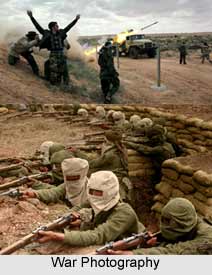 War photography captures images of armed conflict and life in warn-torn areas. It depicts the terrors of war mingled with acts of sacrifice, emotions of civilians and the victims of war and the heroic deeds. Unlike paintings or drawings of war, photographic images are not easily altered; although in some instances, photographers try to manipulate the subjects and scenes depicted in a work, resulting in an image that is not completely objective in nature. Capturing war is named the most unusual kind of photography amongst all the genres. War photography was very common during the World wars. A large number of war photographers came into existence during that time. Photographers of this genre put their lives in danger to capture the essence of war. In order to capture these moments on their cameras many photographers have been killed. These photographs serve as a reminder and the evidence of our historical past.
War photography captures images of armed conflict and life in warn-torn areas. It depicts the terrors of war mingled with acts of sacrifice, emotions of civilians and the victims of war and the heroic deeds. Unlike paintings or drawings of war, photographic images are not easily altered; although in some instances, photographers try to manipulate the subjects and scenes depicted in a work, resulting in an image that is not completely objective in nature. Capturing war is named the most unusual kind of photography amongst all the genres. War photography was very common during the World wars. A large number of war photographers came into existence during that time. Photographers of this genre put their lives in danger to capture the essence of war. In order to capture these moments on their cameras many photographers have been killed. These photographs serve as a reminder and the evidence of our historical past.
Some of the eminent war photographers are Henry Cartier Bresson, Eddie Adams, Robert Capa, George Roger, David Seymor Kevin Carter, Phillip Jones Griffith, Eugene Smith, Alexander Gardner, Bert Hardy, Carl Mydans and the like.
Not many Indians were into war photography. Indian war photography was mostly done during the Indo-Pak war in the year 1965. The one name that comes to mind is of Homai Vyarawalla who was the first Indian Lady photojournalist who later became a part of history in the making, capturing World War II, India`s Freedom Struggle leading up to independence and subsequently the hectic days of Jawaharlal Nehru and Indira Gandhi. Most of the war photographers were army personnel but they were also rare as they were mostly called for duty, so they could not capture those intense and historical moments of war, whether by policy, coincidence or the urgency of the matter. Most of the war photographers for India were British in origin.
Harriet and Robert Tytler and Fellice Beato were two British war photographers who captured the damage caused by the First War of Independence / Indian Mutiny of 1857/8. There were apparently no photographers present to record the scenes at the time of the actual fighting or sieges, and both Tytler and Beato photographed after the British had brutally subdued the uprising. These images were shown to the public by the Photographic Society of Bengal in 1859, and they were also on show (and for sale) at the Tytler`s home in Calcutta. Beato`s photographs of Delhi, Kanpur and Lucknow have become a part of the mythology of 1857 - as document, nostalgia and archive. There are images of the positions of the gun batteries on the Delhi Ridge, Metcalfe house, the Qudsia Bagh, Kashmiri Gate and Mori Gate bastions that were the sites of ferocious fighting.
Then there was John McCosh, who spent much of his life in India during the rule of the East India Company. He participated in the second Sikh War, which resulted in the abrogation of the Sikh kingdom of the Punjab. He took photographs while off duty. Margaret Bourke White was an American photojournalist of the early 1900`s. She is very well known, both in India as well as in Pakistan for her photographs of Gandhi at his spinning wheel and Pakistan`s founder, Mohammed Ali Jinnah, upright in a chair. Sixty-six of Bourke-White`s photographs of the partition violence were included in a 2006 reissue of Khushwant Singh`s 1956 novel about the disruption, Train to Pakistan. Her photographs of the ravages of war recorded streets littered with corpses, dead victims with open eyes, refugees with vacant eyes.
Ami Vitale from New York has been based in India for several years now and is producing memorable work from Kashmir, Gujarat and elsewhere. Her pictures have appeared in exhibits and magazines around the world, including the major publications such as Geo, Time, The New York Times, Newsweek, National Geographic Adventure and more. War photography produced in India in the 19th century, apart from constituting a large body of work, is also of exceptionally fine quality. Produced by both British and Indian photographers, professional as well as amateur ones, this body of work is now in the process of revival and reinterpretation.




